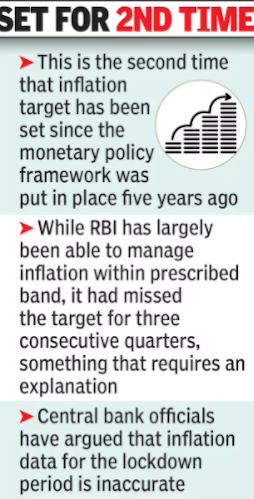Indian Economy
4% Inflation Target Retained by Government
- 01 Apr 2021
- 4 min read
Why in News
The Government of India has decided to retain the inflation target of 4%, with a tolerance band of +/- 2 percentage points for the Monetary Policy Committee of the Reserve Bank of India (RBI) for the coming five years.
- Earlier, the RBI in its Currency and Finance (RCF) report for the year 2020-21 also recommended the inflation target to be kept same as 4% +/-2% for next 5 years.
Key Points
- About:
- To control the price rise, the Centre in 2016 gave a mandate to the RBI to keep the retail inflation at 4% with a margin of 2% on either side for a five-year period ending 31st March, 2021.
- The Consumer Price Index (CPI) tracks the change in retail prices of goods and services which households purchase for their daily consumption.
- The inflation target for the period 1st April, 2021 to 31st March, 2026 under the Reserve Bank of India Act 1934 has been kept at the same level as was for previous 5 years.
- To control the price rise, the Centre in 2016 gave a mandate to the RBI to keep the retail inflation at 4% with a margin of 2% on either side for a five-year period ending 31st March, 2021.
- Background:

- The central bank and the government agreed in 2015 on a policy framework that stipulated a primary objective of ensuring price stability while keeping in mind the objective of growth.
- The Flexible Inflation Target (FIT) was adopted in 2016. The Reserve Bank of India Act, 1934 was amended to provide a statutory basis for a FTI framework.
- The amended Act provides for the inflation target to be set by the Government, in consultation with the RBI, once every five years.
- Inflation Targeting:
- It is a central banking policy that revolves around adjusting monetary policy to achieve a specified annual rate of inflation.
- Inflation targeting is known to bring more stability, predictability, and transparency in deciding monetary policy.
- Strict Inflation Targeting:
- It is adopted when the central bank is only concerned about keeping inflation as close to a given inflation target as possible, and nothing else.
- Flexible Inflation Targeting:
- It is adopted when the central bank is to some extent also concerned about other things, for instance, the stability of interest rates, exchange rates, output and employment.
Monetary Policy
- It is the macroeconomic policy laid down by the central bank. It involves management of money supply and interest rate and is the demand side economic policy used by the government of a country to achieve macroeconomic objectives like inflation, consumption, growth and liquidity.
- In India, monetary policy of the Reserve Bank of India is aimed at managing the quantity of money in order to meet the requirements of different sectors of the economy and to increase the pace of economic growth.
- The RBI implements the monetary policy through open market operations, bank rate policy, reserve system, credit control policy, moral persuasion and through many other instruments.
Monetary Policy Committee
- It is a statutory and institutionalized framework under the Reserve Bank of India Act, 1934, for maintaining price stability, while keeping in mind the objective of growth.
- The Governor of RBI is ex-officio Chairman of the committee.
- The MPC determines the policy interest rate (repo rate) required to achieve the inflation target (4%).
- An RBI-appointed committee led by the then deputy governor Urjit Patel in 2014 recommended the establishment of the Monetary Policy Committee.




